The purpose of this study was to develop a model for the delivery of allied health services to remote communities in north-west Queensland, Australia. The impetus for the study came from general practitioners working in the region, who identified considerable difficulty in accessing allied health professionals (AHPs) for their patients in the regional centre as well as the 11 remote communities, with a complete absence of some allied health disciplines in the area. The outcome of the study was a submission to the Commonwealth Department of Health and Ageing to institute a Regional Health Service based on the proposed Model of allied health service delivery.
The development of sustainable allied health services in remote north-west Queensland, Australia, was challenged by a number of factors including geography, low population density (ranging from 0.03 to 0.55 persons/km2 cultural diversity, and historical difficulty in recruiting and retaining APHs to rural and remote areas.
The target region covers 373 000 km2, and has a population of 16 081. Large distances erode the clinical working time of visiting health professionals, and difficult climactic conditions renders road travel unreliable and hazardous during the prolonged wet season. The populations of the communities in north-west Queensland are small (between 200 and 1400 people) so that full-time employment of resident AHPs is unviable. The region can be described in terms of three distinct precincts (Table 1), and the communities are culturally diverse requiring health professionals to be experienced and sensitive to a range of issues with respect to aboriginal culture, rurality and the remote pastoral industry.
Table 1: Composition of the three precincts of the allied-health service study area
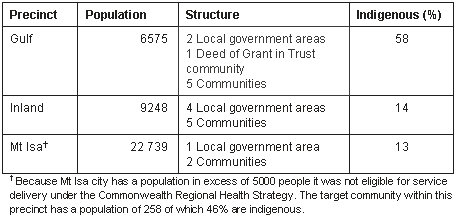
The recruitment and retention of APHs to rural and remote areas is a recognized problem in Australia. A national survey of rural and remote AHPs conducted by Services for Rural and Remote Allied Health (SARRAH) found that the allied health workforce in rural and remote Australia is most likely to be located in a regional centre, with more than half providing services to multiple geographic locations (ie outreach service). Turnover of AHPs was high with 42% of respondents employed in their current position for less than 2 years1.
In Queensland, publicly funded allied health services are provided by Queensland Health. Staff payroll data showed that per 10 000 population, that metropolitan areas had better rates of allied health resourcing than non-metropolitan areas, and that there was considerable variation in the ratio of allied health resources by discipline and district population. The majority of allied health employees were based in hospitals, and those disciplines which have a key role in the provision of community based care (eg occupational therapy, nutrition and dietetics) were not represented in the community in significant numbers when compared with numbers of similar hospital-based personnel. Few allied health services were provided to Indigenous communities, and Indigenous Australians had limited access to occupational therapy, physiotherapy, prosthetics and orthotics, psychology and speech pathology services2.
These two studies have provided evidence for the reasons behind poor retention of APHs in rural and remote areas. The contributing factors relate to management issues, including lack of advocacy; inappropriate line supervision (ie by non-allied health professional); lack of clinical and professional support (particularly in solo positions); difficulties in accessing professional development due to geographic isolation, cost, and lack of information technology access; lack of orientation; unrealistic expectations and pressure on APHs for large caseloads including excessive travel and failure to backfill or delay in recruiting vacant positions, lead to loss of esteem for the allied health positions and a backlog of work.
In the Queensland study, AHPs reported satisfaction with their preparation for clinical practice but dissatisfaction with preparation regarding health systems, workload, business and personnel management, team processes and preparation for rural practice.
The low population density in rural and remote Queensland has led to the development of outreach models of health service delivery. A challenge in the delivery of outreach services is the development of strategies that ensure that services can be delivered in a sustainable manner with respect to both the recruitment and retention of the health professionals, but also in a way that ensures the services provided are effective (ie make a difference).
The philosophy of primary healthcare defined in the United Nations' Declaration of Alma Ata3 is based on a holistic understanding and recognition of the multiple determinants of health, equity in health care, community participation and control over health services, focus on health promotion and disease prevention, use of accessible, affordable and acceptable technology, and provision of health services based on research methods (best practice)4. Primary healthcare operates across the continuum of health education, health promotion, early intervention, primary prevention, treatment, secondary prevention and chronic disease management. Historically, AHPs operate in only the latter part of this continuum (ie treatment, secondary prevention and chronic disease management). This is supported by the Queensland Health study2, where 'few' AHPs participated in public health or primary healthcare activities, and identified a lack of skills and knowledge in primary healthcare-type activities. However, in outreach service delivery the emphasis must be placed on the earlier part of the continuum as services are provided periodically, and there must be self and community development in the management of health issues.
Therefore the aim of this study was to develop an outreach model of allied health service delivery operating in the primary healthcare paradigm.
Methods
The development of the outreach Model of service delivery occurred over four stages. These were:
- Development of a planning matrix
- Environmental scan
- Desktop analysis of previous research relevant to the study
- Synthesis of information to develop a model
Development of planning matrix
The development of the Model commenced with a 'scenario planning workshop' of key stakeholders (Appendix I) convened by the Northern Queensland Rural Division of General Practice at Mt Isa, Queensland, in June 2000.
The purpose of the workshop was to develop a planning framework that would inform and assist the consultant in the development of the model. The workshop drew on the expertise of the stakeholders to identify the key components or elements that the model should address:
- Recruitment
- Retention
- Training
- Housing/location of the service
- Spouse/family support
- Travel
- Employment
The second part of the framework was the identification of specific roles or factors to be considered within the strategies. The workshop participants identified these to be:
- Role of professional organizations
- Information/orientation to communities
- Incentives/remuneration
- Community need/skill mix
- Community role/ownership
- Management
The Model
The outcome of the workshop was the Model, presented as a planning matrix that described the key elements (on the X-axis) and factors/roles (on the Y-axis) that were identified by the workshop participants. The matrix/Model was populated by activities that the participants identified as crucial to each element, and allocated against who was responsible or could contribute to these activities (Table 2).
 | Table 2: The planning matrix that describes the Model of allied health service delivery to remote areas devised by the workshop of key stakeholders at Mt Isa, Australia, June 2000 |
The planning matrix assisted identification of the type of information required to develop a model, from community members, local government, health service providers and AHPs working in north-west Queensland.
Environmental scan
The environmental scan consisted of three components:
- Mapping and gap analysis of existing allied health services.
- Community consultation to inform service mapping, identification of community health issues, and context for service delivery.
- Analysis of available morbidity and mortality data.
Mapping and gap analysis of existing allied health services: A mapping exercise was undertaken to identify current allied health service provision in the 11 target communities. The mapping exercise sought to identify the disciplines, frequency and duration of service provision within each community. The mapping exercise also determined whether there were criteria for referral relating to the specific services.
Using the allied health service map as a basis, the consultant undertook a gap analysis that:
- Identified disciplines available in each target community, and disciplines that were absent
- Identified services that were target specific and therefore only available to a small number of people within a community (eg the occupational therapist employed by Education Queensland only treated specific, identified children)
- Identified positions that had been vacant for an extended period of time
Community consultation: Extensive consultation was undertaken with local/ resident health professionals, consumers, local government, schools, and other community agencies including Home and Community Care (HACC) agency, aged care hostels, ambulance service, indigenous corporations in each of the target communities.
Consultation was undertaken between November 2000 and February 2001. The purpose of the consultation was to:
- Identify perceived health priorities in each community
- Help inform the service mix required in each community
- Provide context for how services should be delivered to meet local need
The consultation was conducted as one-to-one interviews, focus groups and/or community meetings. In the indigenous communities, an indigenous project officer employed by the Division assisted in convening community meetings.
Analysis of available morbidity and mortality data: The morbidity and mortality data sources included hospital separation data for the Mt Isa District, an aggregated sample of screening data from the North Queensland Tropical Public Health Unit (Well Person's Health Check), and diabetes audits of general practices in some of the target communities.
These data were analysed to identify the major causes of mortality and morbidity in the region, with the view to identify the allied health service mix required in the region, and estimate the number of people in a community with a disease such as diabetes, in order to inform the potential number of clients to establish the frequency of visits and number of full time equivalents to service demand and provide best practice care.
Triangulation of data: Information gathered from morbidity and mortality data, screening data, general practice audits, service mapping and gap analysis, and community identified health priorities informed the mix of disciplines required.
Desktop analysis of previous research relevant to the project
The two key areas of research that the consultant drew on to inform the development of the outreach allied health Model related to:
- Recruitment and retention of AHPs
- Determination of a 'reasonable' level of service delivery
Recruitment and retention
The two key documents that the consultant reviewed to inform the factors contributing to poor retention of AHPs in rural and remote areas were Queensland Health's Allied Health Recruitment and Retention Taskforce Report and Fitzgerald et al.'s A Study of Allied Health Professionals in Rural and Remote Australia1,2.
The consultant sought to validate the issues identified in these studies with AHPs working in north-west Queensland. Interviews and focus groups were conducted with 12 AHPs by telephone, videoconference and face-to-face, either individually or in small groups. The disciplines participating included physiotherapists, occupational therapists, psychologists, speech pathologist, dietitian, social worker and pharmacist. The majority of the AHPs interviewed provided predominantly (or some) outreach services. Three held hospital-based positions, and two were private practitioners who had previously worked in the public sector in the region (one in an outreach position and the other hospital-based).
The purpose of the interviews was to explore what attracted the AHP to north-west Queensland, the issues facing AHPs working in north-west Queensland, the core components required to sustain an outreach service, professional development requirements in the remote setting, spouse and family support requirements, factors to be considered in developing a position description and employment contract.
Determination of a reasonable level of service delivery
The consultant was unable to source published information with respect to recommended population to allied health discipline ratios for resident or outreach service provision. A project conducted in the Northern Territory Australia, which developed recommendations for outreach service delivery for several disciplines5 was reviewed. Two other providers of outreach allied health services in Queensland were contacted to examine their models of service delivery.
Synthesis of information to develop the Model
Information gathered by the environmental scan and desktop analysis of previous research was synthesised to identify the disciplines of AHPs required to meet gaps in services and address identified chronic health, mental health and child health issues in the region. Mechanisms for service delivery were developed in response to community concerns about how visiting services had been delivered in the past. Strategies for the recruitment and retention of AHPs were developed to address the management and training issues raised by AHPs in the two recent studies.
The synthesis of information resulted in the development of four options or models of service delivery for consideration by the steering committee. These options sought to meet the criteria identified in the planning matrix. The steering committee identified the preferred option to be further developed by the consultant.
Results
Environmental scan
Mapping and gap analysis: Mapping of allied health services showed that allied health services to the 11 target communities were provided by four agencies: (i) The Mt Isa Health Service District; (ii) The Charters Towers Health Service District; (iii) Education Queensland; and (iv) Bush Children's. The communities received visiting physiotherapy, dietetics, podiatry and psychology services but the frequency of service provision was irregular, and could be withdrawn in response to shortages of staff at the base locations (the towns of Mt Isa and Charters Towers). There were no occupational therapy or speech pathology services to adults in the region, and only a limited provision of these services to children with medium to severe learning and behavioural disabilities.
Community consultation
Perceived gaps in current allied health service delivery: While a range of allied health services was provided to the target communities, the common themes arising throughout the community consultation were problems with frequency of service (identified as ideally 4-6 weekly visits, with preference for visits of a longer duration, ie > 1 day), consistency of service provision particularly if outreach staff were required to back-fill (relieve in) hospital positions, consistency of service provider due to high staff turnover, and the short length of time in a community (Table 3). Of concern was the complete absence of some disciplines (including occupational therapy and speech pathology) for older people, and these disciplines were only available to children who had a level of disability meeting certain criteria.
Other issues identified during the consultation (Table 3) related to:
- Lack of notice when visiting services were coming to a community, therefore low attendance
- Poor coordination with other visiting services resulting in 'bombardment' of communities, with clinic facilities lacking space, and resident staff having difficulty managing clients, and not having time to spend with the visiting health professional for case conferencing or skill development.
- Visits to the communities were too short, with patients left unseen, or missing out on appointments because they did not know the service was in town. The short visits negatively impacted on opportunities for education or inservice training with health workers
- Difficulty defining the system at a local level for referral to visiting services
- Consistency of personnel to build rapport and trust with clients
- Poor promotion/ marketing of visiting services to communities as well as to stations/properties
- Inadequate cultural awareness by visiting health professionals
- Communication with clients in language and level appropriate to the community
Major health issues for the community: While there was agreement between hospital separation data and community perceived health issues with respect to chronic diseases (particularly diabetes and heart disease), hospital separation data is a limited indicator of need as it does not provide information on outpatient or community care pre- or post-hospitalisation, or care that does not result in an admission.
Broad consultation within communities, rather than consultation only with health professionals, identified the need for health professionals to work within a primary healthcare framework. Community members and professionals outside the health sector placed a greater emphasis on visiting services undertaking health education and health promotion activities, and developing skills of local people.
In the Indigenous Australia communities, it was identified that the health professionals should be accessible at sites removed from the hospital/clinic setting. In many Indigenous communities there is an unwillingness for people to attend the hospital or clinic because it is seen as only a place to go when sick, and is associated with death. (There is also the problem of confidentiality in small communities as people are aware of which service is in town and there may be some stigma attached to attending.)
Information gathered during the community consultation placed a strong emphasis on the provision of services to children and older people. The perceived needs related to treatment of children with hearing and speech impairment, and learning difficulties. Similarly, it was felt that for older people, the need for home assessments and follow up after stroke (CVA) were identified. Mental health, and alcohol and substance abuse were identified as major health issues in all but two communities.
Analysis of available morbidity and mortality data
Analysis of Mt Isa District Health Service District hospital separation data showed that the major causes of mortality in the region contributing to greater than 50% of deaths were heart disease and cerebrovascular disease; cancer of the trachea, bronchus and lung, and breast; chronic airways obstruction; motor vehicle accidents; suicide; other accidental injury.
The region was shown to have a high burden of chronic disease evidenced by standardised hospital separations rates for the national health priority areas (ie diabetes, cardiovascular disease, injury, and mental health) being significantly higher than the Queensland average.
Triangulation of the information gathered through the environmental scan indicated the need for a raft of AHPs to address the chronic disease, mental health and child health problems in the region, and augment the services provided by other agencies (ie Queensland Health, Education Queensland and Bush Children's). The disciplines to be included in the model were physiotherapy, dietetics, podiatry, occupational therapy, speech pathology and psychology.
Analysis of relevant research
Recruitment and retention of AHPs in rural and remote areas: Interviews and focus groups conducted with AHPs working in north west Queensland validated issues raised previously by Fitzgerald et al. and the Allied Health Taskforce Report1,2 (both summarised in the Introduction of the present report).
The main issues impacting on the AHPs were professional isolation, lack of clinical support within their discipline, and lack of orientation to the communities they are working with. The AHPs felt professionally isolated because most worked in sole positions within their organizations, and most disciplines (with the exception of physiotherapy) were represented by recent graduates who felt they needed more input from experienced professionals. Orientation to the communities was considered to be important, irrespective of whether the AHP was undertaking outreach work, because it was necessary to understand the living conditions and infrastructure within the communities following client discharge from hospital and follow up.
The key conditions identified by the AHPs to be included in an employment contract were accommodation subsidies that did not cease after a fixed period of time, an airfare to 'home' at least twice a year, paid professional development/conference attendance, 5 or 6 weeks annual leave, professional mentoring, retention payment after a period of service, relocation expenses, post-graduate study leave and assistance with childcare.
As identified in the planning matrix (Table 2), the availability of overnight accommodation for visiting health professionals was important. The standard safety of such accommodation varied, and part of the community consultation involved identifying secure accommodation for visiting AHPs in each community.
Determination of a 'reasonable' level of service delivery: The published recommendations of Curry for outreach service delivery in the Northern Territory of Australia3, and unpublished information from providers of outreach services in other parts of Queensland, recommended service frequency on a monthly basis. In addition, these sources recommended that the duration of visits by AHPs was dependent on the size of the community, the level of morbidity, and whether the health professional undertook health promotion or education during the visit.
A benchmark for the number of AHPs to population could not be found. Therefore, the determination of the number of full-time equivalent AHPs required per discipline was based on the population based Curry's recommendations (ie number of days of service/month x size of community)3. The Mt Isa Health Service District had designated outreach positions for physiotherapy, podiatry and dietetics and this was taken into consideration in calculating the full-time equivalent requirements.
Both Curry and the Queensland outreach service providers identified follow up of clients between visits as a limitation to outreach service delivery3. During the community consultation, health workers in several communities indicated the need to train local people to provide follow up and support to clients to improve outcomes from therapists' interventions6, to build sustainability of the service, and to improve continuity of service when professional staff leave and are replaced.
Description of the Model
The final Model of service delivery sought to address:
- The concerns expressed by communities with respect to how outreach services had previously been delivered
- Factors contributing to the poor retention of AHPs
- Integration with other health-service providers
- Community input into the development of the service, service delivery and ongoing evaluation and review
- Sustainability strategies
Issues or problems identified during the environmental scan and desktop review and the strategies developed in the Model to address these problems are shown (Table 3), demonstrating the strong linkage between the preparatory work of developing the planning matrix, and issues and strategies identified in the research phase. Strategies additional to those identified in planning matrix are shown in Appendix (Appendix II).
Table 3: Strategies identified that supported the Model of allied health service delivery (Table 2) and demonstrate the strong link between the preparatory and research phases
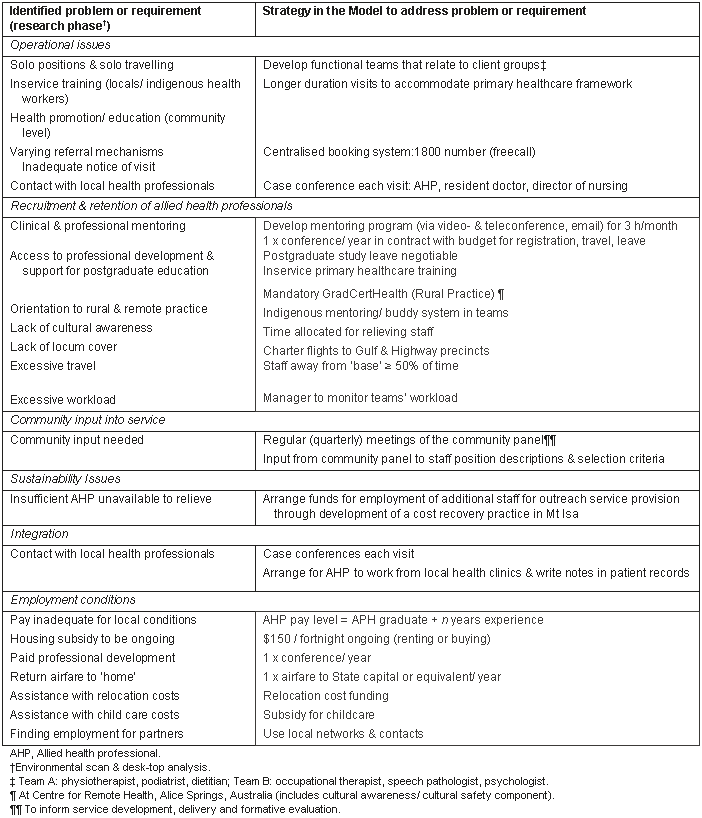
Allied health services are delivered under a hub and spoke model, with AHPs based in Mt Isa. Mt Isa (the hub) is a centrally located inland city that is the commercial and administrative centre for the region; it has a base hospital. The allied health service outreaches to three geographically separate areas (the spokes): (i) the Gulf precinct; (ii) the Highway precinct; and (iii) the Mt Isa precinct (Table 4).
Table 4: The three areas or precincts serviced by the Outreach Allied Health model
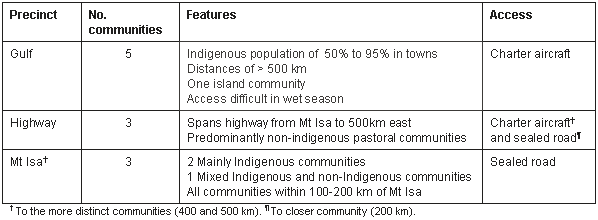
The disciplines identified to be delivered in the region are shown (Table 5); it is planned that they will augment the three outreach positions provided by Mt Isa Health Service District.
Table 5: Disciplines to be delivered in the region shown by full-time equivalent (FTE) status
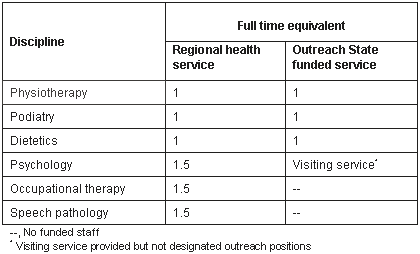
Evaluation
The outreach allied health service Model will be evaluated on a formative and summative basis. The evaluation will target the key domains of recruitment and retention, integration, community impact as well as an economic analysis and cost-effective analysis. The community panel will be integral to the formative evaluation. Necessary revisions to the Model will be negotiated at the management and planning levels to ensure that the Model maintains a primary healthcare focus, accessible to all client groups within the target region, and is achieving improvements in client/community outcomes.
A further aspect of the evaluation will be the impact of enhanced primary healthcare on the utilisation of, and demand for, other local and regional services (ie a flow-on effect). It is planned that this be monitored to assist in health service planning in the secondary and tertiary sectors.
Conclusion
The planning matrix has informed and underpinned the final form of the outreach Model have been given to the utilisation of professional associations and regionally based AHPs for ongoing professional support and mentoring. Formal training, leading to a postgraduate qualification in remote practice, and informal cultural training through the local buddy initiative will be a component of orientation of the AHPs to remote practice and strengthen cultural sensitivities. Remuneration and entitlements reflect isolated practice. Community participation has been integral to the development of the service, and the community panel will provide a structure for ongoing involvement in monitoring and evaluation of the service. Internal management structures, with the employment of an AHP as manager, support line supervision by an AHP and (in the longer term), provide a career path for employees. The development of therapy assistant positions in each community will facilitate management of clients between visits, optimise treatment, provide continuity of service during turnover of AHPs, and build skills within the communities. Ongoing cooperation and service planning by the partner organizations is imperative to sustainable service delivery.
The effectiveness of this Model is yet to be evaluated with respect to access and availability at a community level, client outcomes, and retention of AHPs. However the strategies employed in the development process provide a template for allied health service development in rural and remote areas internationally.
Acknowledgements
This project was funded by the Australian Commonwealth Department of Health and Ageing.
References
1. Fitzgerald K, Hornsby D, Hudson, L. (2000) A Study of Allied Health Professionals in Rural and Remote Australia. A Report to The Rural Health Support, Education and Training Program, Commonwealth of Australia, 2000. http://www.ruralhealth.org.au/sarrah (accessed June 2002).
2. Director General of Health. Allied Health Recruitment and Retention Taskforce Report. Brisbane: Health Advisory Unit, Queensland Health, 2000.
3. World Health Organization. Alma Ata 1978. Primary Health Care. Report of the International Conference, Alma-Ata. Geneva: WHO, 1978.
4. Rogers W, Veale B. Primary health care and general practice: a scoping report. Adelaide, South Australia: Department of General Practice, Flinders University of South Australia, 2000.
5. Curry R. Allied health therapy services in aged and disability care in remote Aboriginal communities of the Northern Territory: a framework for quality service provision. Darwin: Top End Division of General Practice, 1999.
6. Hall M. Integrated therapy assistants and videoconferencing. In: Proceedings, 7th National Rural Health Conference, April 2003, Hobart, Tasmania, Australia; p. 124.
Appendix I: Key stakeholders who participated in the development of the planning matrix
Local general practitioners
Local Government
Royal Flying Doctor Service
Academics with expertise in rural and remote health (Mt Isa Centre for Rural and Remote Health and James Cook University)
Mt Isa District Health Service
Mt Isa District Health Council
Northern Queensland Rural Division of General Practice
Commonwealth Department of Health and Aged Care
Queensland Health Advisory Unit
Queensland Divisions of General Practice
Australian Divisions of General Practice
Return to citation
Appendix II: Additional strategies identified in the research phase of the project to develop a Model of allied health service delivery
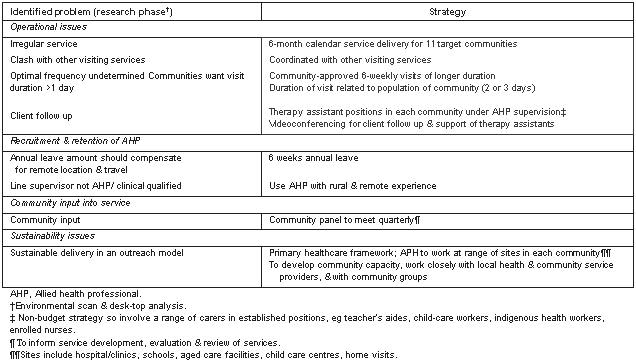
Return to citation

